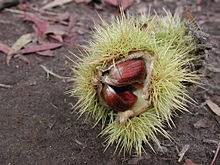Autumn Fruit
Yesterday I saw the chestnut roaster installed in the town where I do my weekly shopping. The smell of the burning wood and the sight of the vendor rolling newspaper into cones confirmed that we are well into the autumn season. He's already been there for the past few Saturdays, but yesterday I noticed him more keenly.
 Every fall I go hunting down lanes and byways for the greenish brown burs filled with chestnuts. I have learned to push and pull with my feet to open them and thus avoid the sharp needles. The chestnuts, roly-poly shining brown, lie scattered around, escaped from burs that fell earlier and split open. Generally I feel lucky if I can gather a half kilo for an evening of roasting. Yes, it would be easier to go to a greengrocer's or a supermarket and just fill a bag from the pile, but it's not the same. There's something about scavenging for autumn fruits that is anciently human and makes you feel good when you have found a quantity that satisfies you.
Every fall I go hunting down lanes and byways for the greenish brown burs filled with chestnuts. I have learned to push and pull with my feet to open them and thus avoid the sharp needles. The chestnuts, roly-poly shining brown, lie scattered around, escaped from burs that fell earlier and split open. Generally I feel lucky if I can gather a half kilo for an evening of roasting. Yes, it would be easier to go to a greengrocer's or a supermarket and just fill a bag from the pile, but it's not the same. There's something about scavenging for autumn fruits that is anciently human and makes you feel good when you have found a quantity that satisfies you.
People either cook them or roast them. We prefer them roasted. There are special roasting pans with holes in the bottom, but we prefer to cut a little skin off and just put them on top of the lit wood stove. After ten or fifteen minutes of pushing them around, making sure they roast on both sides, we sweep them off the stove top with the fire iron and burn our fingers trying to peel the burnt skins off. Sometimes they won't have toasted correctly, so those we put back on the stove. Other times, if someone forgot about them, they'll be brown and hard, completely dry.
As usual, there is a celebration connected with chestnuts. It's the magosto, celebrated in Galicia and other parts of northern Spain and Portugal. It's generally held at the beginning of November and tends to be communal. And the entire village or parish will get together to light a bonfire and bring chestnuts, chourizos, and new wine. The fire is lit in the afternoon and the chestnuts and chourizos roasted on the fire and later eaten in the dark fall evening. Children then take some of the charcoal and rub it on their faces, creating small monsters. There used to be a bagpiper to provide the music as people feasted and tasted the new wine. Now the bagpiper's place has generally been taken over by other musical tastes, though they sometimes still appear. The origins of this celebration are lost in time and little is known of its actual significance. It's thought that the magosto was a way of sharing a meal with the dead where chestnuts would be set aside for them. But that has long been forgotten, and now it's a celebration of living.
From being the cooking staple everyone once used, long before the potato was introduced, it's degenerated to a simple pastime food to enjoy as a snack on a fall evening. A reminder that the days are growing ever shorter and that winter is almost here.
People either cook them or roast them. We prefer them roasted. There are special roasting pans with holes in the bottom, but we prefer to cut a little skin off and just put them on top of the lit wood stove. After ten or fifteen minutes of pushing them around, making sure they roast on both sides, we sweep them off the stove top with the fire iron and burn our fingers trying to peel the burnt skins off. Sometimes they won't have toasted correctly, so those we put back on the stove. Other times, if someone forgot about them, they'll be brown and hard, completely dry.
As usual, there is a celebration connected with chestnuts. It's the magosto, celebrated in Galicia and other parts of northern Spain and Portugal. It's generally held at the beginning of November and tends to be communal. And the entire village or parish will get together to light a bonfire and bring chestnuts, chourizos, and new wine. The fire is lit in the afternoon and the chestnuts and chourizos roasted on the fire and later eaten in the dark fall evening. Children then take some of the charcoal and rub it on their faces, creating small monsters. There used to be a bagpiper to provide the music as people feasted and tasted the new wine. Now the bagpiper's place has generally been taken over by other musical tastes, though they sometimes still appear. The origins of this celebration are lost in time and little is known of its actual significance. It's thought that the magosto was a way of sharing a meal with the dead where chestnuts would be set aside for them. But that has long been forgotten, and now it's a celebration of living.
From being the cooking staple everyone once used, long before the potato was introduced, it's degenerated to a simple pastime food to enjoy as a snack on a fall evening. A reminder that the days are growing ever shorter and that winter is almost here.


Comments
Post a Comment